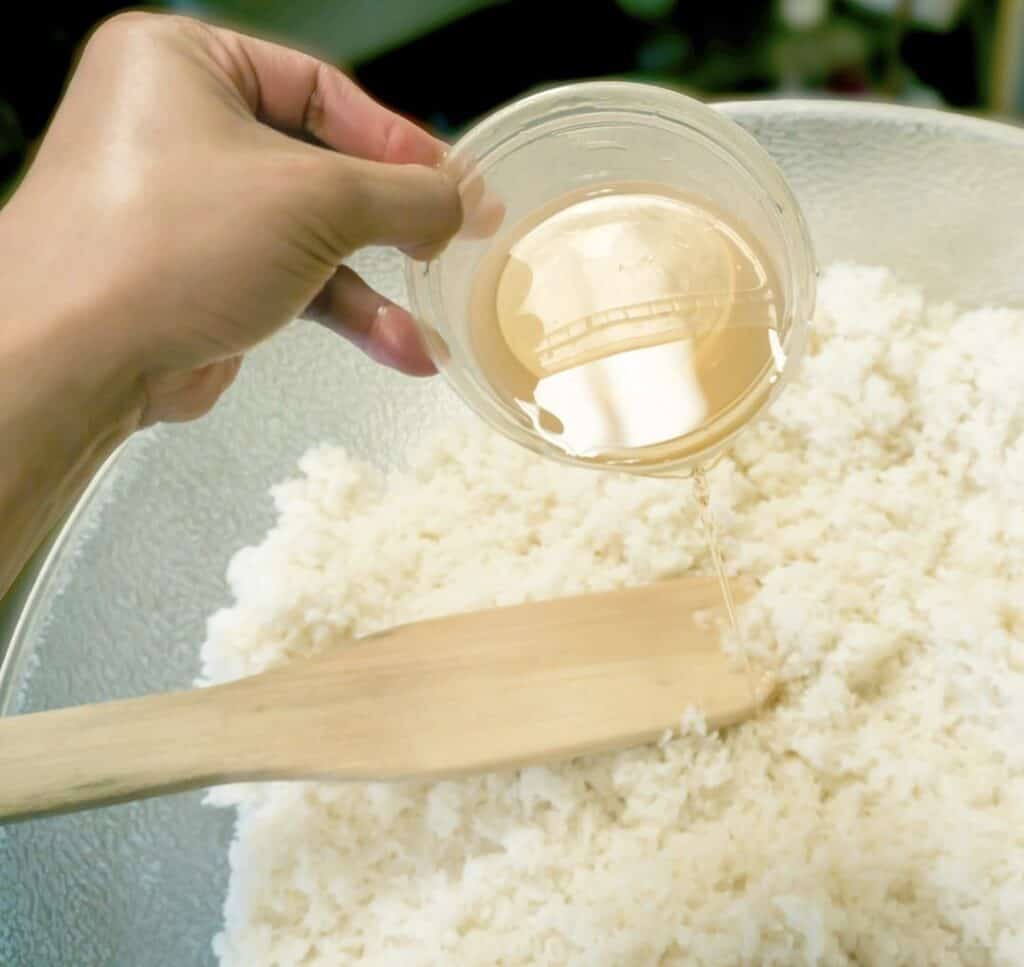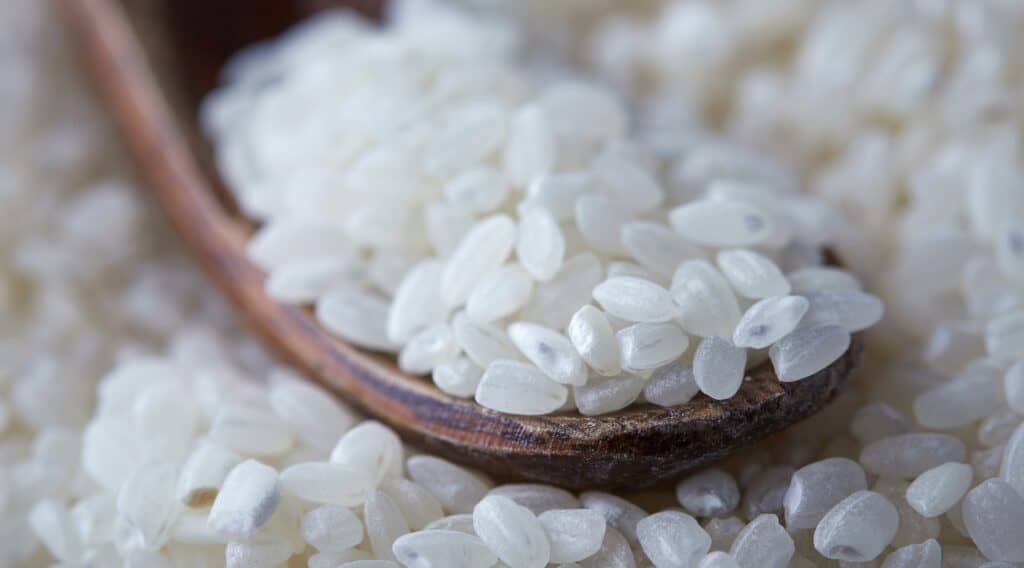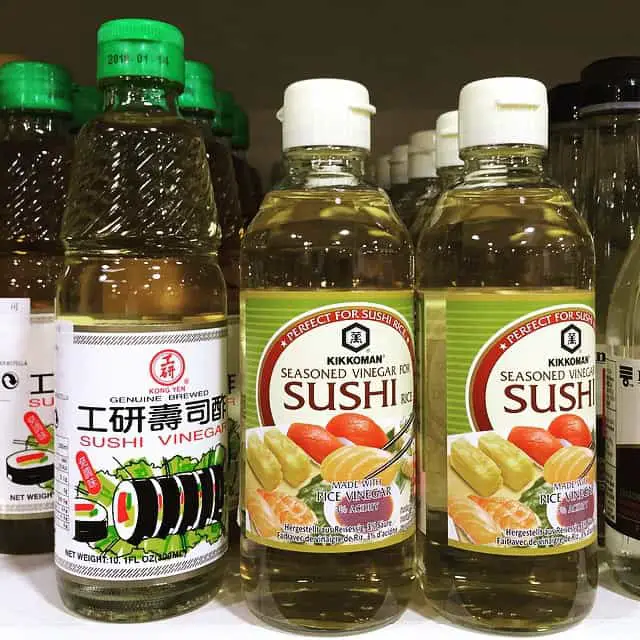Aside from selecting high-quality fish, the key to making your own restaurant-grade sushi at home starts with creating great sushi rice. One of the key ingredients in any sticky sushi rice recipe is vinegar.
So, that being said, how much rice vinegar should you put in sushi rice?
1.5 tablespoons of rice vinegar per cup of rice should be used to make sushi rice. The rice vinegar helps to give the rice a nice flavor and also helps to make it a little sticky, which is necessary for making sushi rolls.


In today’s post, I’m going to talk about using vinegar while cooking sushi rice, especially how much rice vinegar for sushi rice is needed. There are a number of different thoughts on the matter, from how much is enough, what type of vinegar you should use, and whether it affects the consistency of the rice.
Below, I’ll do my best to answer all of the top questions to the best of my ability, based on my own personal experience and research.
If you want to shop online, I recommend buying Sushi Chef’s Sushi Vinegar.
What Happens If You Put Too Much Or Too Little Vinegar In Sushi Rice?
If you do a Google search on how to make your own sushi rice, you’ll notice that almost all recipes call for the addition of sushi rice vinegar.
However, one thing that they don’t seem to agree on is the amount of vinegar. Some recipes may only call for a teaspoon of vinegar per cup of rice, while others call for a 1/4-cup of vinegar per cup of rice.
In my opinion, 1.5 tablespoons is the perfect amount. It’s just enough to create a noticeable taste difference but not enough to overwhelm your taste buds and ruin the taste of the sushi roll.
While the amount of rice you use is also an important factor in the equation, the amount of vinegar in the rice is just as important.
If you put too little vinegar in sushi rice, then you run the risk of it tasting plain and dry. However, if you add too much vinegar to the sushi rice, then you run the risk of it tasting soggy or overly acidic.
Why Is Vinegar Used For Sushi Rice?

If you’ve never made sushi rice before, then you’re probably wondering, why vinegar is even used, to begin with. The answer today is flavoring. Simply put, a little bit of vinegar accentuates the flavor of the seaweed roll and the fish.
You see, in the old days, vinegar was commonly added to many foods (including rice) to prevent bacteria from building up. This was hundreds of years ago, before people regularly washed their hands, before refrigeration, and before pest control was invented. So, keeping the rice bacteria-free for as long as possible was a constant struggle that vinegar helped with.
What Type Of Vinegar Is Best For Sushi Rice?

If you go into the Asian section of your local supermarket or grocery store, you should be able to find a number of different brands of rice vinegar.
If you want to shop online, I recommend buying Sushi Chef’s Sushi Vinegar.
If you can’t find any, then you can substitute with white vinegar or apple cider vinegar.
What Is the Best Sushi Vinegar Ratio?
How much sushi vinegar per cup of rice is needed? The most common ratio when making sushi vinegar is a 1:1 ratio of rice vinegar to sugar. This means that for every 1 cup of rice vinegar, add 1 tablespoon of sugar and stir until it dissolves. Additional ingredients such as salt or mirin (rice wine) may also be added for flavor. The exact ratios can vary depending on personal taste, but this is the standard ratio used in traditional Japanese cooking.
Does Adding Vinegar Affect The Stickiness Of Sushi Rice?
One of the most common misconceptions of sushi rice is that vinegar makes the sushi rice sticky. While a bit of vinegar can make the rice slightly stickier, the stickiness of the rice is primarily determined by the type of rice that you use. Short-grain white rice has the most starch, which means that it will be the stickiest after it’s cooked.
What Other Ingredients Should I Add To Sushi Rice?
Vinegar is arguably the most popular flavor additive that gives sushi rice its distinctive sharp flavor. However, it’s not the only additive that you should be using. Some of the tastiest sushi rice is made by adding a bit of kosher salt and even sugar to the rice mixture after it’s done cooking in the rice cooker.
To get the best flavor, I recommend using 1 tablespoon of white sugar per cup of cooked rice and half of a teaspoon of salt per cup of cooked white rice.
Does Vinegar Make Sushi Rice Last Longer?
Another common misconception about adding rice vinegar to sushi rice is that it will help it stay fresh for longer. Unfortunately, this is not the case. Sticky sushi rice generally only lasts for about 5 hours when left out at room temperature. While you can refrigerate it, it will lose its stickiness within about 24 hours. Adding more or less rice vinegar for sushi won’t change this.
Conclusion
Ultimately, vinegar is mostly added to sushi to enhance its flavor. My golden rule of thumb is to use 1.5 tablespoons of rice vinegar per 1 cup of cooked rice. However, depending on your personal taste preference, you can add a little bit less or more. I always recommend starting with less, and then adding more, as you can take away the vinegar if you accidentally add too much!